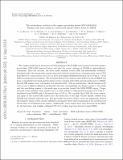Files in this item
The extraordinary outburst in the massive protostellar system NGC6334I-MM1 : flaring of the water masers in a north-south bipolar outflow driven by MM1B
Item metadata
| dc.contributor.author | Brogan, C. L. | |
| dc.contributor.author | Hunter, T. R. | |
| dc.contributor.author | Cyganowski, C. J. | |
| dc.contributor.author | Chibueze, J. O. | |
| dc.contributor.author | Friesen, R. K. | |
| dc.contributor.author | Hirota, T. | |
| dc.contributor.author | MacLeod, G. C. | |
| dc.contributor.author | McGuire, B. A. | |
| dc.contributor.author | Sobolev, A. M. | |
| dc.date.accessioned | 2018-10-04T09:30:11Z | |
| dc.date.available | 2018-10-04T09:30:11Z | |
| dc.date.issued | 2018-10-16 | |
| dc.identifier | 256025312 | |
| dc.identifier | 46fb4bdb-888f-43db-b607-7b4f761c4ebd | |
| dc.identifier | 85055320178 | |
| dc.identifier | 000448150800001 | |
| dc.identifier.citation | Brogan , C L , Hunter , T R , Cyganowski , C J , Chibueze , J O , Friesen , R K , Hirota , T , MacLeod , G C , McGuire , B A & Sobolev , A M 2018 , ' The extraordinary outburst in the massive protostellar system NGC6334I-MM1 : flaring of the water masers in a north-south bipolar outflow driven by MM1B ' , Astrophysical Journal , vol. 866 , no. 2 , 87 . https://doi.org/10.3847/1538-4357/aae151 | en |
| dc.identifier.issn | 0004-637X | |
| dc.identifier.other | ArXiv: http://arxiv.org/abs/1809.04178v1 | |
| dc.identifier.uri | https://hdl.handle.net/10023/16143 | |
| dc.description | C.J. Cyganowski acknowledges support from the STFC (grant number ST/M001296/1). | en |
| dc.description.abstract | We compare multi-epoch sub-arcsecond VLA imaging of the 22 GHz water masers toward the massive protocluster NGC6334I observed before and after the recent outburst of MM1B in (sub)millimeter continuum. Since the outburst, the water maser emission toward MM1 has substantially weakened. Simultaneously, the strong water masers associated with the synchrotron continuum point source CM2 have flared by a mean factor of 6.5 (to 4.2 kJy) with highly-blueshifted features (up to 70 km s-1 from LSR) becoming more prominent. The strongest flaring water masers reside 3000 au north of MM1B and form a remarkable bow shock pattern whose vertex coincides with CM2 and tail points back to MM1B. Excited OH masers trace a secondary bow shock located ~120 au downstream. ALMA images of CS (6-5) reveal a highly-collimated north-south structure encompassing the flaring masers to the north and the non-flaring masers to the south seen in projection toward the MM3-UCHII region. Proper motions of the southern water masers over 5.3 years indicate a bulk projected motion of 117 km s-1 southward from MM1B with a dynamical time of 170 yr. We conclude that CM2, the water masers, and many of the excited OH masers trace the interaction of the high velocity bipolar outflow from MM1B with ambient molecular gas. The previously-excavated outflow cavity has apparently allowed the radiative energy of the current outburst to propagate freely until terminating at the northern bow shock where it strengthened the masers. Additionally, water masers have been detected toward MM7 for the first time, and a highly-collimated CS (6-5) outflow has been detected toward MM4. | |
| dc.format.extent | 3303565 | |
| dc.language.iso | eng | |
| dc.relation.ispartof | Astrophysical Journal | en |
| dc.subject | Stars: formation | en |
| dc.subject | Masers | en |
| dc.subject | Stars: protostars | en |
| dc.subject | ISM: individual objects (NGC 6334I) | en |
| dc.subject | Radio continuum: ISM | en |
| dc.subject | Submillimeter: ISM | en |
| dc.subject | QC Physics | en |
| dc.subject | QB Astronomy | en |
| dc.subject | 3rd-DAS | en |
| dc.subject.lcc | QC | en |
| dc.subject.lcc | QB | en |
| dc.title | The extraordinary outburst in the massive protostellar system NGC6334I-MM1 : flaring of the water masers in a north-south bipolar outflow driven by MM1B | en |
| dc.type | Journal article | en |
| dc.contributor.sponsor | Science & Technology Facilities Council | en |
| dc.contributor.institution | University of St Andrews. School of Physics and Astronomy | en |
| dc.identifier.doi | https://doi.org/10.3847/1538-4357/aae151 | |
| dc.description.status | Peer reviewed | en |
| dc.identifier.url | http://arxiv.org/abs/1809.04178v1 | en |
| dc.identifier.grantnumber | ST/M001296/1 | en |
This item appears in the following Collection(s)
Items in the St Andrews Research Repository are protected by copyright, with all rights reserved, unless otherwise indicated.

